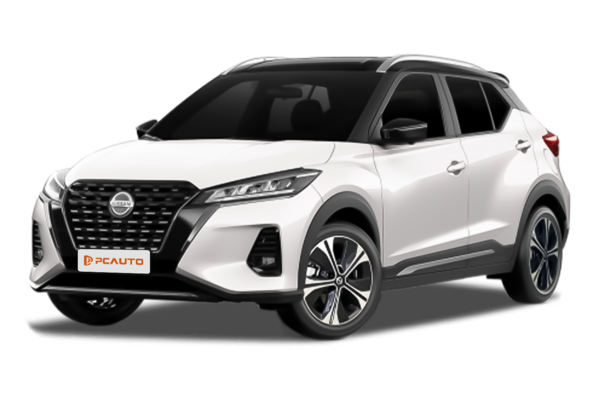Q
What's the safety rating of Nissan Kicks?
Nissan Kicks has performed well in international safety tests. Although it hasn't officially participated in the ASEAN NCAP crash test in the Southeast Asian market, referring to its 5-star rating in the Latin NCAP test in 2018 (the standard version is equipped with 2 airbags) and the "Good" grade it received in some items of the North American IIHS test, it's obvious that it performs well in driving safety. However, for the models in Malaysia, attention should be paid to the specific configuration differences. The local version comes standard with 6 airbags, a Vehicle Dynamic Control (VDC) system, a Hill Start Assist (HSA) system, and a Tire Pressure Monitoring System (TPMS). The passive safety structure adopts the Zone Body high-rigidity vehicle body design. If you have higher safety requirements, it is recommended to choose the high - end version equipped with an Intelligent Emergency Braking (IEB) system and a Blind Spot Warning (BSW) system. Compared with its Japanese competitors in the same class, the safety performance of the Kicks is above average, especially outstanding in low - speed urban protection. Nevertheless, it is still advisable to check the specific safety report of the Malaysian version or have a test drive before purchasing the vehicle.
Special Disclaimer: This content is published by users and does not represent the views or position of PCauto.
Related Q&A
Q
What does D mode mean in Nissan Kicks 2024?
In the 2024 Nissan Kicks, D-Mode stands for Drive Mode – your standard go-to setting for everyday driving. It’s all about striking that sweet balance between power delivery and fuel efficiency, giving you a smooth, predictable ride when you need it most. Now, this little crossover might also come with other modes like Eco for when you’re watching the fuel gauge, or Sport if you feel like spicing things up a bit. But D-Mode? That’s your default, and honestly, it’s perfect for Malaysia’s usual mix of city commutes and highway jaunts. It’ll automatically tweak the throttle response and gearbox logic to keep things running optimally.
For Malaysian drivers, getting the lowdown on D-Mode’s quirks can really help you get the most out of your Kicks. Whether you’re stuck in KL’s legendary traffic snarls or cruising down the North-South Expressway, it’s designed to save you fuel while keeping the drive comfy – a real win-win. Plus, using the right drive mode at the right time isn’t just about immediate comfort; it can actually help keep your ride in good shape for longer. So, don’t be afraid to switch things up based on the road ahead – your Kicks (and your wallet) will thank you for it.
Q
Can a Nissan Kicks 2024 drive in the snow?
The 2024 Nissan Kicks, being a front-wheel-drive-focused compact SUV, demands caution when tackling snowy roads. Sure, it comes packed with essential safety tech like Electronic Stability Program (ESP) and traction control, and those factory-fitted all-season tires work perfectly fine here in Malaysia's tropical climate. But if you're planning a trip to snow-covered areas, swapping in winter tires or throwing on snow chains is a smart move to boost grip. Let's be real, though—with its ground clearance and the lack of a four-wheel-drive system, this urban SUV's ability to handle deep snow or icy surfaces is pretty limited.
For Malaysian buyers, snow driving isn't exactly an everyday scenario, but getting a handle on how your ride performs in different conditions is still a good call. Think about it: cold temperatures can eat into EV range or mess with the battery performance of traditional petrol cars. And when it comes to snow, your tires and driving skills are put to the ultimate test. If you've got plans for an occasional overseas road trip where snow might be a factor, do yourself a favor—research the local road conditions ahead of time and tweak your vehicle to suit. At the end of the day, safety always takes top priority.
Q
Does the 2024 Nissan Kicks have a 360 camera?
The 2024 Nissan Kicks does come loaded with a 360-degree camera system on its higher-spec trims here in Malaysia. This setup uses multiple cameras around the car to give you that handy bird's-eye view, which is a total lifesaver when squeezing into tight parking spots or navigating tricky terrain. It's especially useful for Malaysia's often congested city streets and narrow back lanes. Beyond the 360-cam, you might also find extras like moving object detection and rear cross-traffic alert, which definitely help cut down on those annoying little scrapes and bumps. Quick heads-up though – specs can vary between markets, so Malaysian buyers should definitely check with their local dealer to confirm what's included before signing on the dotted line.
360-degree camera tech first popped up on luxury cars, but it's trickled down to mainstream models these days, becoming a key feature for boosting driving convenience. How does it work? Basically, an image processing chip stitches together feeds from four ultra-wide-angle cameras to create that seamless panoramic view. Some fancier systems even pair it with ultrasonic sensors for more precise distance warnings. For practical-minded Malaysian drivers, these driver aids can take a lot of the stress out of daily commuting. They really shine during the rainy season when roads are slippery, or at night when visibility is poor – that's when you'll appreciate having that extra set of "eyes" the most.
Q
How to open trunk on Nissan Kicks 2024?
Here's how to pop the trunk on the 2024 Nissan Kicks – it's super straightforward, with a few handy ways to do it. The most direct method is using the trunk release button on your remote fob; just hold it down for about a second and it'll unlock automatically. Then there's the trunk switch panel on the left side of the driver's dashboard, perfect for quickly accessing the cargo area when you're parked inside the car. If your Kicks is equipped with the smart proximity feature (usually on higher trim levels), simply walk up to the tailgate with your key in your pocket or bag and press the button on the door itself to unlock it.
A really cool convenience feature on the 2024 Kicks is the hands-free foot-activated liftgate – though you'll want to check your specific configuration to confirm it's included. Just wave your foot under the rear bumper, and the radar system triggers the trunk to open automatically – total lifesaver when your hands are full with groceries or gear.
For our Malaysian drivers, here's a quick pro tip: keep an eye on the tailgate struts and make sure they stay lubricated. The local hot and humid climate can speed up rubber component wear, so a little maintenance goes a long way. And if you ever run into electrical issues, there's a manual emergency release lever behind the rear seat – good to know for those just-in-case scenarios. These little touches really show Nissan's thoughtfulness about real-world use.
Just remember, trim levels and features can vary a bit by market, so always flip through your owner's manual to confirm exactly what your Kicks is packing.
Q
How much oil for 2024 Nissan Kicks?
The 2024 Nissan Kicks has an oil capacity of approximately 3.7 liters, including the oil filter replacement. It's recommended to use 5W-30 viscosity oil meeting API SN or higher standards. The exact capacity might vary slightly depending on the engine variant or regional specifications, so it's best to check the owner's manual or consult an authorized Nissan dealer in Malaysia for precise details.
In Malaysia's hot climate, regular oil changes are crucial – typically every 5,000 to 10,000 kilometers or 6 months, whichever comes first. High temperatures can cause oil to oxidize faster, so opting for a quality fully synthetic oil will provide better engine protection.
When checking the oil level, make sure the vehicle is parked on level ground and wait a few minutes after turning off the engine to allow the oil to drain back into the sump for an accurate reading. If adding oil yourself, pour small amounts gradually and check the dipstick repeatedly to avoid overfilling, which can increase engine resistance or damage seals.
Q
Do 2024 Nissan Kicks have heated seats?
Whether the 2024 Nissan Kicks in Malaysia comes with heated seats depends entirely on the local specs. From what I’ve seen, Southeast Asian models usually prioritize ventilation and breathability over heating—makes total sense given the tropical climate, right? If you’re after better seat comfort, keep an eye on other tech features it might offer, like premium fabric seats or maybe optional upholstery upgrades. Malaysian buyers should definitely note that trim levels can vary by region, so hitting up your local Nissan dealer is the best move to get the exact specs. Truth is, for tropical markets, stuff like ventilated seats and UV-protected glass are way more practical than heaters—little details that actually work with the weather. And hey, it never hurts to cross-shop with other subcompacts to see how their seat features stack up. That way you get the full picture of what’s out there.
Q
Are 2024 Nissan Kicks AWD or FWD?
The 2024 Nissan Kicks hits the Malaysian market strictly as a front-wheel drive (FWD) offering – no all-wheel drive (AWD) variant is on the cards here. Under the hood, you'll find a 1.6-liter naturally aspirated engine paired with a CVT gearbox, a combo that prioritizes fuel efficiency and nimble city handling – perfect for Malaysia's typical urban traffic and climate. FWD does a solid job on slippery roads or your daily commute, plus it keeps things mechanically simpler and cheaper to maintain. AWD, while great for serious off-roading or extreme conditions, just isn't a must-have for everyday Malaysian driving. The Kicks also packs in some nice safety and tech features, like intelligent emergency braking and blind spot monitoring, to sweeten the deal. If you're a Malaysian shopper on a budget but still want a high-value SUV, the Kicks is definitely one to check out.
Q
How much does it take to fill up a 2024 Nissan Kicks?
The 2024 Nissan Kicks in Malaysia comes with a 41-liter fuel tank. At Malaysia's current RON 95 petrol prices – around RM2.05 per liter as of December 2023, for example – a full tank will set you back roughly RM84. Of course, the actual cost can vary slightly depending on fuel price fluctuations and how much fuel is left in the tank when you refuel.
Notably, this model is powered by a 1.6-liter naturally aspirated engine paired with a CVT transmission. Nissan claims a combined fuel consumption figure of 6.0 liters per 100 kilometers, which translates to an approximate maximum range of 680 kilometers on a full tank. That makes it well-suited for city commuting and short road trips.
Malaysian drivers should also keep in mind that real-world fuel efficiency can be influenced by factors like driving style, traffic conditions, and air-conditioning usage. Regular maintenance, such as changing the air filter and keeping the tires properly inflated, can help further optimize fuel economy.
Additionally, the Kicks features a resin fuel tank, which not only helps reduce the vehicle's overall weight but also offers better corrosion resistance. These kinds of details highlight the balance Japanese cars often strike between practicality and engineering ingenuity.
Q
Do Nissan Kicks 2024 have cruise control?
From what we know so far, the 2024 Nissan Kicks does come with cruise control in some markets, but exact specs can vary by region and trim level. For Malaysian buyers, your best bet is to hit up your local Nissan dealer to get the full lowdown on what the Malaysia-spec model offers.
Cruise control is a real lifesaver on long drives – it automatically maintains your set speed, takes the edge off driver fatigue, and just makes the whole journey more relaxed. These days, with car tech advancing so quickly, even budget-friendly SUVs are starting to pack in these handy features. Some even step it up with fancier active cruise control (ACC), which can automatically adjust your speed to keep a safe gap from the car in front.
If you're shopping for a new ride in Malaysia, besides cruise control, keep an eye out for other safety goodies like automatic emergency braking and lane-keep assist – they can seriously boost your on-road safety. Just a heads-up though: different brands and models tend to name their driver-assist systems differently, and the features can vary too. So when you go for a test drive, make sure to ask the dealer to walk you through exactly how each system works.
Q
Does the Nissan Kicks 2024 have a heated steering wheel?
From what we know so far, the 2024 Nissan Kicks doesn't come standard with a heated steering wheel in the Malaysian market. That feature's usually found on higher trim levels or as part of an optional package in colder climate markets. Being a tropical country, Malaysian buyers tend to prioritize things like ventilated seats that better suit the local weather. But if a heated wheel is something you're really set on, it's worth hitting up your local Nissan dealer to see if there's a special edition or if they can sort out a post-purchase installation. Some premium models do offer that kind of personalization these days.
It's also worth noting that heated steering wheels are still pretty rare on Japanese SUVs priced below the RM200k mark. Even rivals like the Honda HR-V and Toyota Corolla Cross don't offer it much either – it just comes down to what Southeast Asian buyers typically prioritize.
Tech-wise, modern heated steering wheel systems are pretty solid. Using carbon fiber or resistance wires, they can warm up to a comfortable temp in 3-5 minutes, and they don't guzzle juice – think about the same power draw as your average car headlight. If Malaysian consumers start asking for more comfort features down the line, you might see automakers adjust their spec sheets. For now though, your best bet is to check Nissan Malaysia's online configurator or, better yet, swing by a dealership for a test drive to see what the actual car comes with.
Popular Cars
Model Year
Car Compare
Car Photo
Latest Q&A
Q
Does the 2019 Golf GTI have a timing belt or chain?
The 2019 Golf GTI uses a timing chain instead of a timing belt—a design that offers better durability and lower maintenance costs. Typically, a chain lasts as long as the engine itself and rarely needs replacement, whereas a belt requires inspection or replacement every 60,000 to 100,000 km. If neglected, a worn belt can snap and cause severe engine damage.
VW’s EA888 engine family has long relied on chain-driven systems, which are relatively quiet and highly reliable. That said, it’s crucial to periodically check the tensioner’s condition. Some earlier models experienced timing issues due to tensioner design flaws, but this was addressed in the 2019 version.
For performance enthusiasts, a chain system handles high-revving stress better, making it a common choice for hot hatches like the GTI. For daily driving, just stick to VW 50400/50700-spec oil as recommended in the manual—proper lubrication keeps the chain system healthy long-term.
One heads-up: If you hear noticeable metallic rattling near the front of the engine, have the guides or tensioner inspected ASAP. Unlike the telltale belt squeal before failure, this noise is a classic sign of chain-related wear.
Q
What is the recall on the 2019 GTI?
The 2019 Volkswagen Golf GTI was subject to a safety recall addressing two potential issues. First, the fuel pump control unit software could malfunction, potentially causing engine stalling in rare cases. Second, some vehicles might have rear suspension stabilizer link bolts that weren't tightened to specification, posing a loosening risk. Owners can visit authorized dealers for free software updates or bolt retightening.
These proactive recalls demonstrate Volkswagen's commitment to safety. Dealers often handle outstanding recall items during routine maintenance.
For performance-oriented models like the GTI, it's wise to go beyond recall checks. Pay close attention to the turbo system, DSG transmission fluid, and brake wear—these components endure more stress during spirited driving. If warning lights appear or you notice unusual noises, get a professional inspection promptly. Keeping the car in top shape ensures you can fully enjoy its dynamic capabilities.
Q
Does the 2019 GTI require premium gas?
The 2019 GTI does recommend using high-octane fuel (typically RON 95 or above). Its 2.0L turbocharged engine has a relatively high compression ratio, and premium gas ensures optimal performance while reducing knock risk. It also helps maintain engine cleanliness and long-term reliability.
While the car may tolerate lower-octane fuel (like RON 92), you’d see slightly reduced power output and fuel efficiency. Over time, it could also affect engine longevity. Turbocharged engines are particularly sensitive to octane ratings since turbos generate higher heat and pressure—high-octane fuel handles these conditions better.
Mixing different fuel grades occasionally won’t hurt, but sticking to the manufacturer’s recommendation is ideal. Also, periodic fuel additive treatments can help clean carbon buildup, especially for direct-injection engines.
One more thing: even with the same octane rating, fuel additive packages vary by brand. So, picking a reputable gas station matters too.
Q
How long will a 2019 GTI last?
The lifespan of a 2019 GTI largely depends on maintenance and driving habits. With regular oil changes, transmission fluid replacements, and avoiding aggressive driving, it can easily clock over 200,000 kilometers—or even more. Its 2.0T engine and DSG gearbox are proven combos, and as long as you stick to the factory service schedule, mechanical reliability won’t be an issue.
Just keep in mind: turbocharged engines demand extra care. Always use the right spec full-synthetic oil and monitor the cooling system. Climate plays a role too—hot, humid conditions mean paying extra attention to rubber seals and electronics. Every 50,000 km, have the timing chain and high-pressure fuel pump inspected (key items for turbos).
Driving style matters. Don’t redline it constantly, and let the engine warm up properly after cold starts. Rustproofing helps long-term durability, so regular underbody washes are smart. Nail these details, and this car’s built to last.
Q
How fast is the 2019 GTI?
The 2019 GTI truly delivers when it comes to performance. Under the hood lies a punchy 2.0-liter turbocharged four-cylinder, churning out 228 horsepower and 350 Nm of torque. Whether you opt for the engaging 6-speed manual or the lightning-fast 7-speed DSG, this hot hatch rockets from 0-100 km/h in just 6.3 seconds, with an electronically limited top speed of 250 km/h.
What really sets the GTI apart is its razor-sharp handling. The sport-tuned suspension and electronic differential lock work together to deliver precise steering and rock-solid cornering stability. It’s the perfect blend of everyday practicality and proper driver’s car thrills—a well-rounded hot hatch in every sense.
For enthusiasts, the GTI’s tuning potential is massive. Many owners go for ECU remaps or intake/exhaust upgrades to squeeze out even more power. Just remember to keep things street-legal—safety and compliance should always come first. Around here, these pocket rockets have a solid following, and it’s easy to see why.
View MoreRelated News

Nissan Kicks e-Power lands in Malaysia, hybrid, with a range of 900 kilometers!
MichaelNov 12, 2024

The New NISSAN Kicks Debuts at the New York Auto Show, Adding a Four-wheel Drive System
Kevin WongMar 28, 2024

It used to be as powerful as Hilux, but now it has to avoid competing with Hilux.
Kevin WongNov 18, 2025

In Malaysia, which sliding door MPVs are available?
MichaelOct 30, 2025

Nissan plans to open the Rogue hybrid platform to competitors like Ford to ease financial pressure
Kevin WongOct 11, 2025
View More

















Pros
Cons